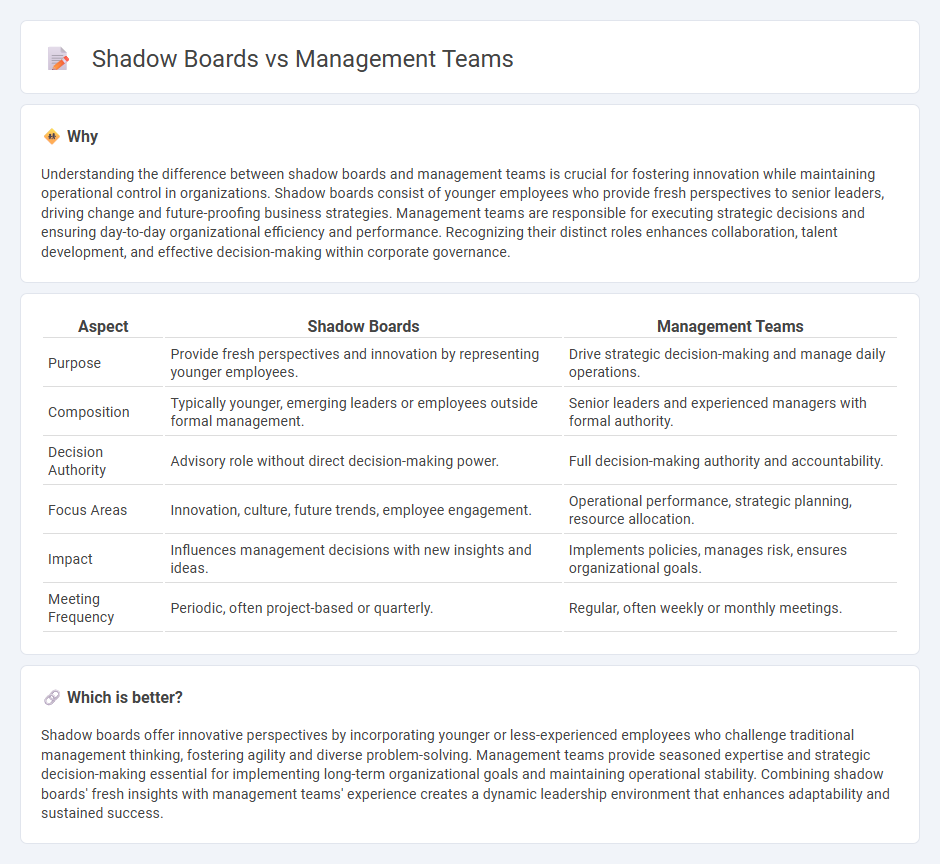
Shadow boards consist of diverse, often younger employees who provide fresh perspectives and innovative ideas to traditional management teams, fostering dynamic decision-making and bridging generational gaps. Management teams hold formal authority, focusing on strategic planning, resource allocation, and execution of organizational goals. Explore how integrating shadow boards can transform leadership and enhance corporate agility.
Why it is important
Understanding the difference between shadow boards and management teams is crucial for fostering innovation while maintaining operational control in organizations. Shadow boards consist of younger employees who provide fresh perspectives to senior leaders, driving change and future-proofing business strategies. Management teams are responsible for executing strategic decisions and ensuring day-to-day organizational efficiency and performance. Recognizing their distinct roles enhances collaboration, talent development, and effective decision-making within corporate governance.
Comparison Table
| Aspect | Shadow Boards | Management Teams |
|---|---|---|
| Purpose | Provide fresh perspectives and innovation by representing younger employees. | Drive strategic decision-making and manage daily operations. |
| Composition | Typically younger, emerging leaders or employees outside formal management. | Senior leaders and experienced managers with formal authority. |
| Decision Authority | Advisory role without direct decision-making power. | Full decision-making authority and accountability. |
| Focus Areas | Innovation, culture, future trends, employee engagement. | Operational performance, strategic planning, resource allocation. |
| Impact | Influences management decisions with new insights and ideas. | Implements policies, manages risk, ensures organizational goals. |
| Meeting Frequency | Periodic, often project-based or quarterly. | Regular, often weekly or monthly meetings. |
Which is better?
Shadow boards offer innovative perspectives by incorporating younger or less-experienced employees who challenge traditional management thinking, fostering agility and diverse problem-solving. Management teams provide seasoned expertise and strategic decision-making essential for implementing long-term organizational goals and maintaining operational stability. Combining shadow boards' fresh insights with management teams' experience creates a dynamic leadership environment that enhances adaptability and sustained success.
Connection
Shadow boards operate as dynamic advisory groups composed of younger employees who provide innovative perspectives, directly influencing the strategic decisions of formal management teams. These entities foster cross-generational collaboration, enhancing management's ability to adapt to market trends and drive organizational agility. Integration of shadow boards ensures that management teams incorporate diverse viewpoints, promoting inclusive leadership and improved decision-making processes.
Key Terms
Decision-making authority
Management teams hold formal decision-making authority within organizations, responsible for strategic planning, resource allocation, and operational execution. Shadow boards, composed of younger or non-executive employees, provide advisory insights and innovative perspectives but lack official decision-making power. Explore the distinct roles and influence of management teams and shadow boards in shaping corporate strategy.
Diversity of perspectives
Management teams often consist of experienced executives whose decisions reflect established company goals and operational expertise, potentially limiting innovative viewpoints. Shadow boards, composed of younger or more diverse employees, introduce fresh perspectives and challenge conventional strategies to foster innovation and inclusivity. Explore how integrating shadow boards with management teams can enhance decision-making through diverse viewpoints.
Organizational hierarchy
Management teams typically consist of senior leaders responsible for strategic decision-making within the formal organizational hierarchy, ensuring alignment with company goals and operational execution. Shadow boards are composed of younger employees who provide fresh perspectives and challenge conventional thinking, operating parallel to the existing hierarchy to influence innovation and cultural change. Explore the distinct roles and benefits of these groups to understand their impact on organizational dynamics.
Source and External Links
What are Management Teams? - Management teams are groups of top managers, including the CEO, who oversee daily operations and strategic direction, working cooperatively across functions to lead the organization effectively.
What Are Management Teams? Definition and How To ... - Management teams vary by business but typically include key executive roles such as CEO, CFO, CMO, and COO, each focusing on specialized areas like finance, marketing, or operations.
What is a Management Team? What is its purpose ... - A management team's purpose is to run the operational side and set strategic plans of an organization, often structured around the top leader's direct reports and meeting regularly for effective leadership and cooperation.
 dowidth.com
dowidth.com